A Wool Lover’s Visit to the North of England
The trip I went on in May with Rowan Tree Travel to southwestern England was so wonderful that I had to go again on a similar trip in northern England at the end of September.
The trip I went on in May with Rowan Tree Travel to southwestern England was so wonderful that I had to go again on a similar trip in northern England at the end of September.
(Bet you didn’t see that headline coming …)
A pair of 3000-year-old pants was found in western China’s Tarim Basin. The wool trousers were most likely worn by horse riders. Along with studying how they were made, a modern reproduction of these pants has also been created. Find out more about this archaeological find at https://www.sciencenews.org/article/pants-oldest-ancient-horseman-asia-culture-origin and https://www.sciencenews.org/article/first-pants-worn-horse-riders-3000-years-ago
PLY Magazine believes that Black lives matter, as well as LBGTQI+ lives. Those most vulnerable and persecuted in our communities deserve our love and support. Please be good to each other.
Did you know we also have a monthly PLY newsletter? Sign up here!
Did you know we also have a monthly PLY newsletter? Sign up here!
Archaeologists have made some textile discoveries in the past year that are of interest to spinners and clothmakers.
In Turkey, at a rather large Stone Age settlement known as Çatalhöyük, cloth was found in 1962. It took decades of discussion and new data and discoveries to determine if the cloth was made from wool or linen. Ultimately, researchers determined the cloth was made from bast fiber from oak trees. (from Norwegian SciTechNews)
In Spain, in a cave near Cordoba, archaeologists found a piece of fabric that is “the oldest evident of textiles in the Iberian Penninsula.” This loom-woven fragment is about 5400 years old. (from The Olive Press)
In Wales, in an Iron Age hillfort, one of the artifacts founds was a “stone spindle whorl.” (from The Past)
Two burial mounds in Poland, from the Wielbark culture about 2000 years ago, contained a number of items related to weaving such as spindles and spools. (from Heritage Daily)
In Norway, a number of discoveries have been found along Viking trade routes. One well-preserved piece of clothing has been called the “Lendbreen Tunic” and was made of wool. Also find was a distaff made from birch. (from Artnet News)
PLY Magazine believes that Black lives matter, as well as LBGTQI+ lives. Those most vulnerable and persecuted in our communities deserve our love and support. Please be good to each other.
Did you know we also have a monthly PLY newsletter? Sign up here!
Did you know we also have a monthly PLY newsletter? Sign up here!
Today Christina Pappas returns to the blog to walk us through the process of replicating a 2000-year-old slipper!
Today we are going to focus on getting to know the slippers for this project. (Have a look at my post from last week to learn more about my replication project.)
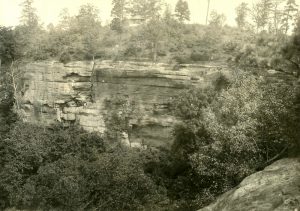 Footwear from 2,000 years ago is really different from what most of us wear today. Going barefoot was probably not uncommon, but there were times when you wanted something on your feet. For example, imagine exploring a cave barefoot. How far could you walk barefoot? Probably not very far. Mammoth Cave in Kentucky is the longest cave system in the world (over 400 miles and counting!) and ancient peoples had explored much of it thousands of years ago. We know they wore slippers because we have found slipper fragments inside the cave.
Footwear from 2,000 years ago is really different from what most of us wear today. Going barefoot was probably not uncommon, but there were times when you wanted something on your feet. For example, imagine exploring a cave barefoot. How far could you walk barefoot? Probably not very far. Mammoth Cave in Kentucky is the longest cave system in the world (over 400 miles and counting!) and ancient peoples had explored much of it thousands of years ago. We know they wore slippers because we have found slipper fragments inside the cave.
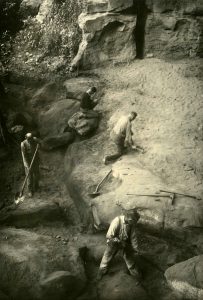 Several of the slippers were excavated from rockshelters in the 1920s and 1930s as a part of the Works Progress Administration (WPA). These images are from a rockshelter in Lee County in Kentucky that produced three of the slippers. Images courtesy the William S. Webb Museum of Anthropology, University of Kentucky.
Several of the slippers were excavated from rockshelters in the 1920s and 1930s as a part of the Works Progress Administration (WPA). These images are from a rockshelter in Lee County in Kentucky that produced three of the slippers. Images courtesy the William S. Webb Museum of Anthropology, University of Kentucky.
We also find fragments of slippers in dry rockshelters. Rockshelters are places along rock walls where you can find shelter from the elements – the kind of place you would rest while hiking to get out of the rain. Kentucky has many rockshelters that are dry, and archaeologists have been able to recover perishable artifacts, including slippers, from these kinds of sites.
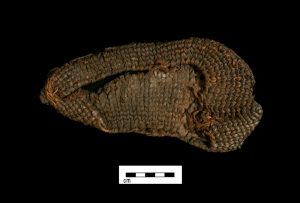
A twined slipper from a rockshelter in Kentucky.
For the slippers we’re going to make, we have to look at several examples to piece together all the necessary traits. All the slippers we’ll be looking at are in the collection of the William S. Webb Museum of Anthropology at the University of Kentucky. They are all from archaeological sites in Kentucky, and most from rockshelters. Only a couple of have been radiocarbon dated directly, but all are approximately 2,000 years old (give or take a few hundred years).
All the slippers are made from plant materials. I can see that the fibers are long, and there is a bit of the outer stem left on some fibers. That tells me that these fibers were not subjected to a lot of processing and appear to be bast fibers. Unfortunately, I can’t completely determine what plant fiber was used; I would need to cut samples and examine them with a microscope to be certain. I do know that these are not from milkweed or nettle fiber, since those fibers are finer than what was used in these slippers. The ancient craftspeople who made these slippers used something woody and hard-wearing, quite possibly fiber from the pawpaw.
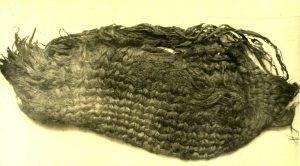
A (slightly different) twined slipper from a rockshelter in Kentucky. Image courtesy the William S. Webb Museum of Anthropology, University of Kentucky.
These slippers are all chevron or countered twined. Twining is one of the oldest textile structures with examples dating to over 40,000 years ago in the Old World. In twining, two yarns twist around a third stationary yarn. You can twist every row in the same direction, or you can alternate the direction of each row to create a pattern as was done in our slippers. Twined slippers are made both ways; chevron twining just happens to be my favorite.
The paired yarns that twist are our wefts, and the stationary yarns are our warps. The weft yarns on all our slippers are singles, with a slight Z-twist of 20-30 degrees. The average diameter is about 0.5 cm (about 0.2 inches). The warps are a bit tricky to see and learn about.
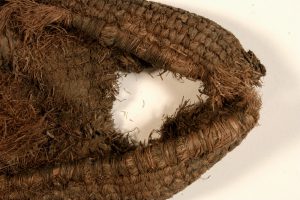
A close-up of the heel of a slipper where you can see the plant fibers and the twining structure.
Slippers had to be durable and hard-wearing, so they were twined very tightly and the wefts covered the warps. In the places where the weft has rubbed away, the warp was also damaged and the original yarn structure is not always clear. What I’ve been able to see is that both plied and unplied yarns were used in the warp. A plied yarn was used for the warps near the edge of the slippers, and unplied yarns were used for the warps in the middle. A plied yarn was also used at the toe of the slipper. It functioned like a drawstring to snug the slipper up around your foot.
Using plied yarns makes sense at the edges and as a drawstring – those are the areas where the slipper would take a good amount of abuse and a plied yarn would stand-up better over time. The plied warp yarns are two Z-spun singles S-twisted together, and the unplied warps are Z-spun singles. The warps average about 0.8 cm (about 0.31 inches) in diameter. The plied yarns average about 1.5 twists/cm and the unplied warp yarns average 0.5 twists/cm. I wasn’t able to get a measurement for the twists/cm for the weft yarns. The dense twining made it difficult to get consistent measurements.

A slipper toe where you can see the drawstring. You can find a drawing of a completed slipper here.
So, what have we learned so far?
I know that my slippers will need to be made out of a ‘harder’ bast fiber. Pawpaw was used prehistorically for slippers, and I know a few farmers who still grow them. My fiber will need minimal processing. I will use chevron twining to weave my slippers. My yarn goals are:
I’m going to have to figure out how to process my fiber, how to spin my yarn, and how to weave my slipper. These are all steps that will be based on what I’ve learned from other fiber artists and early historic descriptions of spinning in the Southeast, not on anything we know for sure from the archaeological record. This is where the real trial-and-error begins!
Next time we chat, we’ll get to know the other textiles for this project.

Chris Pappas is an archaeologist by day and a fiber fanatic by night who is happiest when she can be both at the same time. She lives in Kentucky with her husband, adorable baby girl, and two crazy beagles.
We are thrilled to have regular contributor Christina Pappas back on the blog today – take it away, Chris!
So here’s the thing – I wasn’t supposed to be an archaeologist, let alone a textile archaeologist.
When I was in high school, I was the epitome of the nerdy art student. I always had paint on my clothes and a sketchbook tucked into my backpack. My plan was to go to college and study art; I even had a partial scholarship to help. My senior year, when I should have been putting my portfolio together, I was daydreaming about a different path. I loved history, and my constantly stained clothes proved I didn’t mind getting dirty, so I started thinking about what else I could do.
For a class project I had interviewed the curator of Egyptology at the Brooklyn Museum of Art. He was an archaeologist and told me what his job was like. He was brutally honest about the hard work and low pay, but it was still the most exciting job I could think of. I did a bit of research and found an archaeology program with an emphasis of hands-on experience. My parents were surprised but supportive, though my dad did encourage me to take ‘a nice accounting class’.
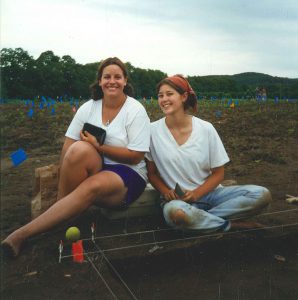
My first archaeological dig! My friend Ruth (right) and I (left) in the Allegheny National Forest, circa 1998. Alas, we did not find any textiles that summer.
Mercyhurst University is a small liberal arts school located in northwestern Pennsylvania on a hill overlooking Lake Erie. Students in the Anthropology program were expected to work in the labs, either through work-study or on a volunteer basis. Even as a college freshman, you were expected to be there. The work was not glamorous – I washed and labeled artifacts (mostly window glass!) – but I loved it.
After your freshman year, you chose a specialty and started working under a professor with that expertise. You could study stone tools, ceramics, historic artifacts, or perishables and textiles. I will admit that I had no idea what I wanted to do. I was much more interested in my social life at that point and the cool kids of our department all worked in the perishables lab. That’s right folks: I did not choose to study perishables and textiles because I saw their importance in explaining cultural process or because I had a burning desire to understand the technology of textile production. I wanted to hang out with the cool kids.
I’ll let that sink in for a minute.

Hard at work in the perishables lab, sometime in late 2000. The perishables lab has continued to change and today’s lab is very different from when I was student. The training, however, is still as rigorous today as it was nearly 20 years ago.
At the time, the perishables lab was directed by Dr. James Adovasio, one of the foremost experts on archaeological textiles (he’s better known for his work at Meadowcroft Rockshelter and peopling of the New World – but that’s a different story for another day). In hindsight, I realize now how fortunate I was to work under him, but at the time I was just really excited. My goal of hanging with the cool kids was quickly set aside. I loved working in the perishables lab! My first project was working on carbonized textiles and yarns from a Bronze Age site in Jordan. These fragments of cloth were thousands of years old and woven from carefully spun linen thread. I learned to identify the different textile weaves, how to pick apart the structure of a plied yarn, how to see all the tiny decisions that went into the making of the object. That’s what pulled me in.
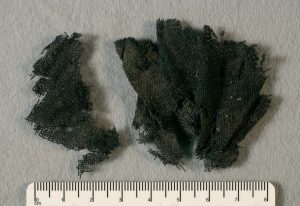
Carbonized linen textiles from an early Bronze Age site in Jordan. These textiles date to approximately 2350 BC and were among the first objects I worked on in the perishables lab.
As fiber folk, we all know the feeling. You look at a handmade textile and you see not just a pretty object, but the hours at the loom or knitting needles, the fiber drafting at the wheel, the alchemy at the dye pot, even the shepherds with their flocks. You can see all the steps and decisions that went into creating that object, all the places where one path or another was chosen. Archaeologists are constantly trying to trace back those paths, to see those moments when a decision had to be made and why. The whys are how we learn about culture in the distant past. We can look to the past and see when and why spinning one kind of fiber over another was chosen, what changes were happening that lead to that decision, and what were the ramifications of that decision. Best of all, we can take what we learned from those ancient decisions and apply that knowledge to the same kinds of problems we face today. Want to know how today’s cotton farmer should respond to increasingly arid conditions? Let’s see what they did 2,000 years ago and how it panned out.
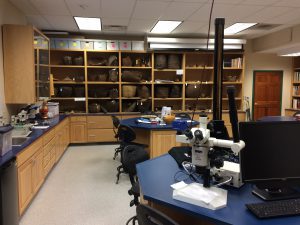
The current perishables lab at Mercyhurst
My career (thus far!) has been full of happy accidents. I missed the deadlines to apply for an internship at the Metropolitan Museum of Art in New York City my junior year of college so I wrote a letter asking if I could volunteer. My dedication and enthusiasm impressed the head of the Textile Conservation department so much that she used her own research funds to hire me as a conservation assistant for the summer. I would work on and off at the Met for the next three years learning everything from basic object care to what scanning electron microscopes can tell us about textiles (it’s a lot – especially when you’re working with gilded yarns).
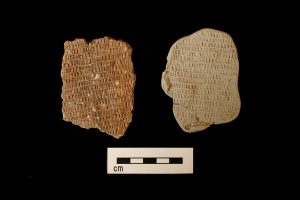
I analyzed textiles impressed in pottery to see how social organization changed after political collapse during the Late Prehistoric in Kentucky.
I came to graduate school at the University of Kentucky intending to study the earliest Americans but once again found myself drawn the to the kinds of cultural questions textiles can help us answer – how do we respond to change? I looked at impressions of textiles in pottery to see how cultural groups reorganized themselves after the collapse of their political system, a surprisingly relevant topic in today’s world. Along the way, I worked with textile collections from the Sudan, Egypt, Asia, Peru, and of course, Kentucky. No matter where you find yourself in the world, textiles are a language spoken by everyone.
Through it all, I’ve always found the easiest way to understand textile production was to learn how to do it myself. What better way to know what can influence the choices of a spinner or weaver than to become one? I still advocate that anyone who wishes to study ancient textiles needs to learn how make them and any student who works with me finds themselves with a spindle in hand before too long.
These days, most of my research is focused on the ancient yarns and textiles from dry rockshelters in Kentucky and the greater southeast. At work, there are still plenty of opportunities for surprises. Yesterday a collection of textiles from an 1895 time capsule in Louisville showed up on my desk. I’ll need to clean and analyze them to see what they can tell us about life in Louisville 120 years ago. There’s always something new to learn!

Chris is an archaeologist by day and a fiber fanatic by night who is happiest when she can be both at the same time. She lives in Kentucky with her husband, adorable baby girl, and two crazy beagles.
This site uses cookies. By continuing to browse the site, you are agreeing to our use of cookies.
OKLearn moreWe may request cookies to be set on your device. We use cookies to let us know when you visit our websites, how you interact with us, to enrich your user experience, and to customize your relationship with our website.
Click on the different category headings to find out more. You can also change some of your preferences. Note that blocking some types of cookies may impact your experience on our websites and the services we are able to offer.
These cookies are strictly necessary to provide you with services available through our website and to use some of its features.
Because these cookies are strictly necessary to deliver the website, you cannot refuse them without impacting how our site functions. You can block or delete them by changing your browser settings and force blocking all cookies on this website.
These cookies collect information that is used either in aggregate form to help us understand how our website is being used or how effective our marketing campaigns are, or to help us customize our website and application for you in order to enhance your experience.
If you do not want that we track your visist to our site you can disable tracking in your browser here:
We also use different external services like Google Webfonts, Google Maps and external Video providers. Since these providers may collect personal data like your IP address we allow you to block them here. Please be aware that this might heavily reduce the functionality and appearance of our site. Changes will take effect once you reload the page.
Google Webfont Settings:
Google Map Settings:
Vimeo and Youtube video embeds:
